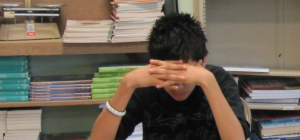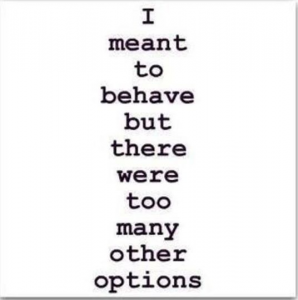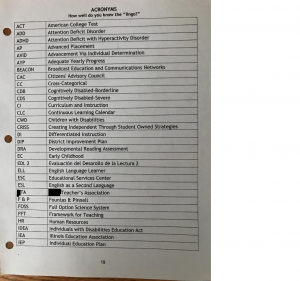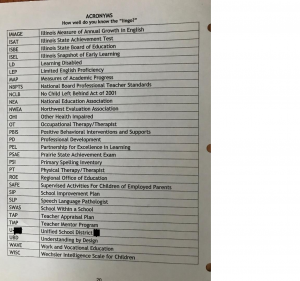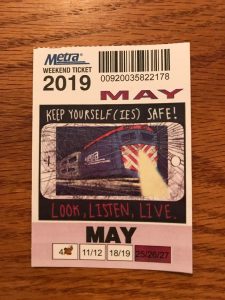(A post mostly for newbies, among others.)
Let me recommend a website designed to spotlight the topic of attendance: http://awareness.attendanceworks.org. This battle needs to be fought, and with the many details involved in starting the year, a few repeat absences can slip by teachers. In severely overcrowded classrooms, those absences may even seem welcome. My first year of teaching, I started with forty students in my Spanish 1 classes, and I will frankly confess that when the count fell into the low thirties I often felt relieved.
But that’s another problem — overcrowding — and another post.
Attendance problems frequently develop into a downward spiral. Studies show children with erratic attendance get lower grades and less positive reinforcement for the academic efforts they do make. Children with lower grades and less positive reinforcement become more likely to avoid school in the future when the opportunity arises. Attendance has become one of the invisible elephants hiding in the room with us, too often given only lip service when reformers push for rising test scores in traditionally academically-challenged districts.
I’d like to start with why the month September itself matters. When I did a google search on this topic, I came up with “Absences Add Up: How School Attendance Influences Student Success” By Alan Ginsburg, Phyllis Jordan and Hedy Chang, August 2014, an article on the some of the affects of absenteeism.
From the Ginsberg, Jordan and Chang article:
APPENDIX II:
A. Why September Matters: Improving Student Attendance
… poor attendance early in the school year can predict chronic absence. In Why September Matters: Improving Student Attendance, Linda S. Olson studies attendance in the Baltimore City Public Schools for pre-kindergarten through 12th grade students in September and throughout the rest of the 2012-13 school year. She focused on students who missed 20 days of school in excused or unexcused absences…
The study found:
• Students who missed fewer than 2 days in September typically had good attendance rates for the entire year.
• Half the students who missed 2-4 days in September went on to miss a month or more of school, which is known as chronic absence. This group missed an average of 25 days.
• Nearly 9 out of 10 students who missed more than 4 days in September were chronically absent that year. These students missed an average of 70 days.
Let’s pause to focus on that last number: 70 days. Seventy days??!? That’s approaching half the school year. Maybe Stephen Hawking could have continued his academic progress with that little help from the educational system, but almost nobody else will be ready for the next year’s curriculum after a nuclear educational blow of that magnitude.
B. Chronic Absence and Its Effects on Students’ Academic and Socioemotional Outcomes:
… August 2014 in the Journal of Education for Students Placed at Risk … researcher Michael A. Gottfried at the University of California Santa Barbara used a U.S. Department of Education data base that tracks 10,740 students. That data base, known as the Early Childhood Longitudinal Study, includes results for kindergarten tests measuring reading and math ability, as well as six social and emotional skills. … Gottfried divided the absentee students into two levels — those missing 11 to 19 days (what he calls “moderate”) and those missing 20 or more days (which he calls “strong”).
Gottfried’s findings include:
• About 13 percent of the students were chronically absent — 10 percent of them at the moderate level and 3 percent at the strong level.
• Chronically absent students at both levels performed below their better-attending peers on math and reading skills assessments. The differences were wider in math than reading, and more significant for those missing a month or more than for those at the moderate level.
• Chronic absence is associated with a lack of certain social skills, including a child’s ability to pay attention, work independently, adapt to change and persist in tasks. It also reflects a lack of eagerness to learn new things and a lack of engagement in school. Again, the differences are greater for the students who miss more school. Poor attendance did not correlate with a child’s ability to control emotions or make friends.
It’s tough to know where to go with these results. From Absences Add Up | Attendance Works, we learn the following:
• Those with worse attendance showed decreases in their engagement in school and eagerness to learn by the spring testing.
• Family circumstances mattered for chronic absence. Students from low-income families whose parents were not married were more likely to be chronically absent.
• Parent involvement mattered for chronic absence. Students with lower absences had parents who were more likely to take them to book stores, music lessons or tutoring, among other activities.
While I don’t normally venture into preschool and early childhood waters — I don’t know much about early childhood education since I always taught in middle and high schools — I left the last section of that block quote because the bullet points emphasize the importance of family involvement in attendance. Preschool attendees fare better in the absenteeism picture, but that strikes me as natural. Parents who go out of their way to get early education for their kids can be expected to value education more highly than parents who don’t seek out that education.
Most of the above references to data about absenteeism are intuitive. You don’t need a weatherman to see which way the test-scores blow with chronically absent students. Chronically absent students hardly ever succeed academically.
The question that faces teachers is this: Can I influence attendance enough to help at least some of my students? I am writing this post because my experience suggests that, yes, you can. Call home. Call home again. If your districts allows or encourages the practice, go to that home. You have to tackle that “one more day won’t matter” mantra. Some parents respond to their sense that the teacher cares, that the teacher will be disappointed in them if little Audrey does not make it to the bus. This issue should be a September priority, too, before bad habits set in.
Admittedly, absenteeism can sometimes prove impossible to manage. I have referred a number of students without success to truancy programs designed to manage the chronically absent. Sadly, if mom insists on keeping Hedy home to babysit her little sisters and brother when she cannot find a sitter, authorities may talk and talk to mom, but that talking may not get Hedy to school on babysitting days. If dad cannot drive Slater to school after he misses the bus and dad cannot get himself up in time to get Slater ready for the bus, Slater will miss school. You cannot fix all the dysfunctional family dynamics out in the world.
Still, I believe engaging parents in understanding the long-term effects of absenteeism can help. Helping will require preparing a speech. The above URL could be a good place to start. The internet is overflowing with helpful data about long-term effects from chronic absences — even if specifics can be extremely difficult to nail down.*
I approach absenteeism like I approach the latte effect, which I first heard explained by Ben Stein. One latte may only be $4.00, an inexpensive indulgence. Why not? The “why not” comes later. If I buy that latte every day, by year’s end I will have spent $1,460 on my coffee. In the same vein, a day here, a day there, and by the end of the school year a student may have missed more than 5 weeks of a 36 week school year. Few students can recover academically from that loss of time, even if the loss occurred in dribs and drabs. I then talk about math specifically because it’s easy for parents to see how missing math can make every future school year more miserable.
Eduhonesty: What can you do? Parent education has the potential to rescue a Hedy or Slater. Teach the attendance version of the latte effect to parents. Share the results from studies showing long-term academic damage from regular absences. Share tips that will help control the problem, such as scheduling doctor and dentist appointments after school or first thing in the morning. Emphasize that family vacations should not overlap the school year. Help parents figure out alternative transportation for when students miss busses. Can an aunt or uncle help? Make it gently clear that bad weather hardly ever justifies missing school. You might have parents send a change of clothes for students who are wet or cold. Heck, if all else fails, go to a resale shop and buy a few coats for needy students. If you explain your purpose, sometimes you can get phenomenal deals.
Parents respond to teacher concern. If they are shown the data that connects absenteeism to poor performance, some parents will shift that doctor appointment from 11:30 AM to 8 AM to minimize class hours lost. Some parents will decide to postpone the family visit to Puerto Rico until the start of school vacations.
This post falls into the category of “More work at the start of the year and I am already buried now!” As with other advice in this blog, many teachers can skip making these attendance calls. If you work in a school with excellent attendance, you may have nearly perfect attendance all year. But regardless of a school’s attendance patterns, I’d call on any student who missed three days in September and any who miss two without an obviously good reason, starting by expressing concern for the absent student. When you call, you may want to bundle up other useful information into the call. This is a perfect time for reminders about Open House or parent conferences. Those reminders help prevent parents from going on the defensive.
For those of you working in schools that suffer from chronic absenteeism, I’d suggest looking at last year’s absenteeism (if you can lay hands on that data) and calling the parents of all potential problem students. I’d call home at the first absence for any new students. I’d also present a version of my “absenteeism leads to poor academic performance” at conferences, with the understanding that the parents you most need to reach are ironically the most likely to miss conferences.
While teachers cannot control attendance, we can definitely make improvements in a classroom’s overall absenteeism rate. I put up shiny stars on my data board, tracking student attendance for the class. I wrote down student names on the left of a laminated poster and then gave a star for every week of good attendance. At the end of the month, students received awards for having no unexcused absences. Showing students you care can make a difference, day by day.
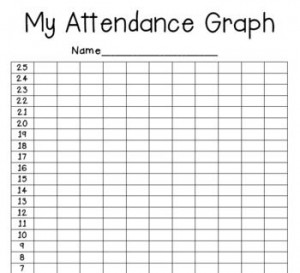
P. S. I know an almost surefire way to identify struggling Title 1 schools. Look for those attendance charts with the stars on them. In wealthier, academically successful schools, those attendance charts are not found on the walls.
*Historical note: I once spent some time looking up high school data in the Illinois state interactive report card. I went to annual yearly progress (AYP) data for 2013 to check attendance success, since No Child Left Behind (NCLB) tracked attendance. As far as I could tell, all high schools in Illinois had an attendance rate of 92% and a graduation rate of 85%. The state’s attendance data seemed genuinely wacky. I’d love to know that story, but that too is another post.



